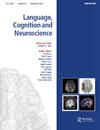Does linear position matter for morphological processing? Evidence from a Tagalog masked priming experiment
IF 1.8
3区 医学
Q2 AUDIOLOGY & SPEECH-LANGUAGE PATHOLOGY
引用次数: 0
Abstract
ABSTRACT This study investigated morphological decomposition of Tagalog infixed, prefixed, and suffixed words using the masked priming paradigm. We directly compared morphological priming of infixed, ni- prefixed and -in suffixed words to examine whether infixes are processed similarly to other affixes during early and automatic decomposition. We found significant priming effects for infixed, prefixed, and suffixed words, but no semantic or orthographic similarity priming. Magnitudes of priming effects for infixed and prefixed words were not significantly different, suggesting that decomposition of infixed words was not more costly for Tagalog speakers, contrary to phonological readjustment-based accounts of infixation. This is the first psycholinguistic experiment showing that infixed words are decomposed into morphological units during visual word recognition. We provide evidence that the imperfect edge-alignment of the stem within infixed words does not hamper the early morphological decomposition mechanisms, suggesting that edge-alignment might not be critical to trigger activation of morphological units.线性位置对形态学处理有影响吗?Tagalog掩蔽引发实验的证据
摘要本研究采用掩蔽启动范式研究了他加禄语中缀词、前缀词和后缀词的形态分解。我们直接比较了内缀词、ni前缀词和-in-后缀词的形态启动,以检验内缀词在早期和自动分解过程中的处理是否与其他词缀相似。我们发现内缀词、前缀词和后缀词有显著的启动效应,但没有语义或拼写相似启动。内缀词和前缀词的启动效应大小没有显著差异,这表明内缀词的分解对他加禄语使用者来说并不更昂贵,这与基于语音调整的内缀解释相反。这是第一个心理语言学实验表明,在视觉单词识别过程中,内缀词被分解为形态单元。我们提供的证据表明,内缀词中词干的不完美边缘对齐不会阻碍早期的形态分解机制,这表明边缘对齐可能对触发形态单元的激活并不重要。
本文章由计算机程序翻译,如有差异,请以英文原文为准。
求助全文
约1分钟内获得全文
求助全文
来源期刊

Language Cognition and Neuroscience
AUDIOLOGY & SPEECH-LANGUAGE PATHOLOGY-BEHAVIORAL SCIENCES
CiteScore
4.50
自引率
13.00%
发文量
70
期刊介绍:
Language, Cognition and Neuroscience (formerly titled Language and Cognitive Processes) publishes high-quality papers taking an interdisciplinary approach to the study of brain and language, and promotes studies that integrate cognitive theoretical accounts of language and its neural bases. We publish both high quality, theoretically-motivated cognitive behavioural studies of language function, and papers which integrate cognitive theoretical accounts of language with its neurobiological foundations.
The study of language function from a cognitive neuroscience perspective has attracted intensive research interest over the last 20 years, and the development of neuroscience methodologies has significantly broadened the empirical scope of all language research. Both hemodynamic imaging and electrophysiological approaches provide new perspectives on the representation and processing of language, and place important constraints on the development of theoretical accounts of language function and its neurobiological context.
 求助内容:
求助内容: 应助结果提醒方式:
应助结果提醒方式:


